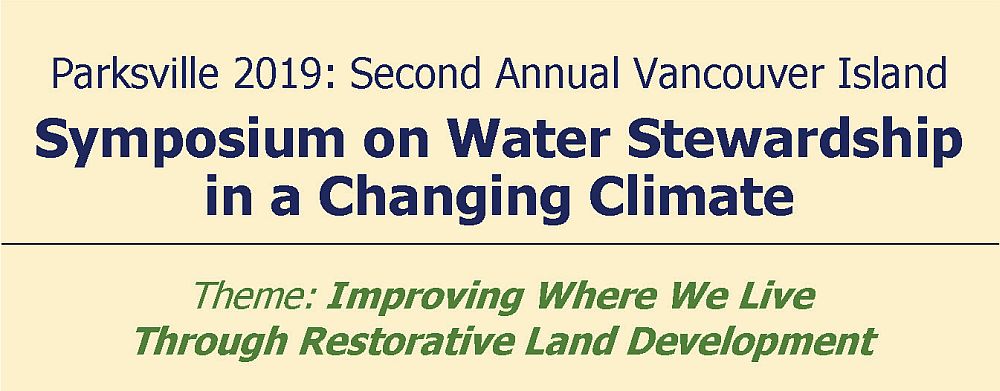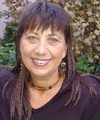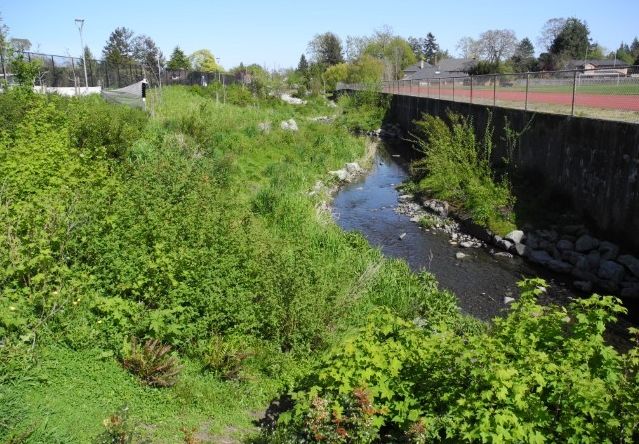IMPROVING WHERE WE LIVE: Bowker Creek and Brooklyn Creek are “beacons of hope” on Vancouver Island / Learn more at Parksville 2019 (Announcement #8, March 2019)
Note to Reader:
Teamwork for the common good is a powerful and often transformative experience, particularly when a longer term vision for a local creekshed engages multiple interests, disciplines and local government. Collaboration taps into the passion and ingenuity of volunteers who are driven by commitment.
On Vancouver Island, “beacons of hope” are the Bowker Creek and Brooklyn Creek restoration initiatives. Provincially significant precedents, each has a long history in demonstrating how local government partnerships with stewardship groups can “improve where we live”.
These precedents represent a range of situations: Bowker in the urban heart of the Capital Region; Brooklyn in the suburban Comox Valley. These case studies are the focus of the afternoon session on Day Two of the Parksville 2019 Symposium.
Join delegates from the east coast of Vancouver Island and beyond, and attend a ‘watershed moment’ in the City of Parksville on April 2-3-4 for a field day followed by the 2-day symposium. The bridge between the two symposium days is a free public lecture by Storm Cunningham, author of The Restoration Economy. Storm’s lecture is titled “Nature Is Regenerative: We should be too”.
Each day, there is a dedicated town-hall session. On Day One, “Watershed Health and You” features the Englishman River watershed system. A different 5-person panel will prime the audience each day. On Day Two, “Improving Where We Live” features five Vancouver Island initiatives. A different 5-person panel will prime the audience each day.
Delegates will leave Parksville 2019 with an understanding that restorative land development results in sustainable stream restoration.

CITIZEN SCIENCE IN ACTION – Brooklyn Creek Watershed Society volunteers in the Comox Valley
“Agree on the vision. Set the targets. Provide planners with the detail necessary to guide site level decisions as opportunities arise. Then implement,” urges Jody Watson, Capital Regional District
“Looking through the ‘worth lens’ culminated in a fundamental shift in philosophy regarding how to value natural assets in Comox,” reports Marvin Kamenz, Town of Comox
For contextual background, follow these links to previous announcements:
- Backgrounder #1 – Professional Reliance Review & Restorative Development Vision Set the Stage
- Backgrounder #2 – Decrease Destructive Footprint While Increasing Restorative Footprint
- Backgrounder #3 – Local Government Partnerships with Stewardship Sector Can Be Transformational
- Backgrounder #4 – Root Causes of Degraded Urban and Rural Streams
- Backgrounder #5 – Next Decade of Drinking Water & Watershed Protection in the Nanaimo Region
- Backgrounder #6 – Restorative Land Development Results in Sustainable Stream Restoration
- Backgrounder #7 – Closing the Data Gap: Water Stewards, the Key to the Future
TO LEARN MORE:
FOR THE COMPLETE STORYLINE, DOWNLOAD THE PARKSVILLE 2019 BROCHURE.
ALSO DOWNLOAD PARKSVILLE SYMPOSIUM AGENDA
CLICK ON THIS LINK TO REGISTER: https://www.civicinfo.bc.ca/event/2019/Parksville-Water-Stewardship-Symposium JOIN US IN PARKSVILLE ON APRIL 2-3-4

Citizen Science in Action
Stewardship operates under a different dynamic than the private sector or government. Stewards are drawn together for a common cause, like-minded individuals with a vision for the greater good. This purpose is not to be found in the policy manuals of government, nor in regulations or legislation. Rather, it is built upon an enthusiastic personal commitment and passion by a band of individuals to make a difference.
Financial gain is not a factor, nor is fame, and hard work is not grudged. Collaboration, teamwork and a recognition that the whole is greater than the sum of its parts is the energy that stokes the creativity and determination, based upon each individual contributing their particular talent.
When this combination of citizen talent is aligned with a local government that is both visionary and focused, outstanding achievements are not only possible, but realistic, and often with nominal financial outlay. In essence, engagement of community through stewardship is a credible formula to be encouraged and mainstreamed at every opportunity.
The Bowker Creek and Brooklyn Creek restoration success stories on Vancouver Island are inspirational because they demonstrate how local government partnerships with stewardship groups can be transformational.
Bringing Bowker Creek Back to Life in the Capital Region: Community Buy-In is Key
A Blueprint for Action
A decade in the making, and approved by all three municipalities as of 2012, the Bowker Creek Blueprint: A 100-year action plan to restore the Bowker Creek watershedresulted from a unique multi-jurisdictional effort. Outreach proved to be a powerful tool for building community and political support.
The Bowker process demonstrates that four ingredients are essential for a successful creekshed restoration strategy, namely – champions inside and outside government, broad-based collaboration, perseverance by individuals in all walks of life, and sustained commitment over decades by local governments. Ultimately, Bowker Blueprint implementation hinges on embedding details into operational work plans. This is happening.
A Watershed Moment
Replacement of the old Oak Bay High School with a new facility created the opportunity for a flagship creek restoration project. Completed in 2015, this has been a catalyst for action – for example, the Bowker Creek Developers’ Guide, in collaboration with the Urban Development Institute.
 “Channel restoration at Oak Bay High was a true ‘watershed moment’ for the creek and the community. It is a wonderful example of how a long-term coordinated plan to restore function to a degraded watershed can happen, piece by piece, and when opportunities arise, when we work together towards a common vision,” states Jody Watson, Capital Regional District. Jody is Supervisor, Environmental Partnerships & Initiatives. Now Past-Chair, Bowker Creek Initiative, she provided strong leadership for a decade and a half (i.e. from 2004 through 2018)
“Channel restoration at Oak Bay High was a true ‘watershed moment’ for the creek and the community. It is a wonderful example of how a long-term coordinated plan to restore function to a degraded watershed can happen, piece by piece, and when opportunities arise, when we work together towards a common vision,” states Jody Watson, Capital Regional District. Jody is Supervisor, Environmental Partnerships & Initiatives. Now Past-Chair, Bowker Creek Initiative, she provided strong leadership for a decade and a half (i.e. from 2004 through 2018)
“The Bowker Blueprint is the outcome of a landscape-based and action-oriented process. It is a truly integrated plan to restore watershed function over time. Agree on the vision. Set the targets. Provide planners with the detail necessary to guide site level decisions as opportunities arise. Then implement.”

Bowker Creek Channel Restoration at Oak Bay High School
A Tale of Two Creeksheds in the Town of Comox:
Base Decision-Making on “Worth”
The “Comox hour” is an integrated presentation that blends three perspectives to showcase the long-term value of collaboration guided by a shared vision for creekshed restoration. The 3-person team comprises Christine Hodgson of the Brooklyn Creek Watershed Society, and two members of the Town of Comox leadership team, namely: Al Fraser (Parks) and Marvin Kamenz (Planning). Their storytelling will prime the audience for a town-hall conversation about “improving where we live”.
First, Al Fraser will provide context for the Comox journey, with a focus on partnerships. Then, Christine Hodgson follows with a show-and-tell about Brooklyn Creek. Finally, Marvin Kamenz elaborates on three building blocks in the evolution of the Town’s incremental process for implementing changes in development practices: lower Brooklyn Corridor, North East Comox, and new areas tributary to the middle Brooklyn Corridor.
Brooklyn Creek
The lower corridor is a regional amenity destination, reflecting the beneficial impact of the investment by the Town and the Brooklyn Creek Watershed Society in stream stabilization and riparian area enhancement. The Partnership for Water Sustainability selected Brooklyn Creek as a working example of how to apply the Ecological Accounting Process (EAP) to value the worth of a creekshed, its hydrology, and ecological systems.
 “EAP focuses on the worth of ecological services to residents,” states Marvin Kamenz, Municipal Planner. “Worth deals with real numbers which local governments need to deliver outcomes. The worth of a creekshed is defined as a package of ecological services made possible by the hydrology.
“EAP focuses on the worth of ecological services to residents,” states Marvin Kamenz, Municipal Planner. “Worth deals with real numbers which local governments need to deliver outcomes. The worth of a creekshed is defined as a package of ecological services made possible by the hydrology.
“Looking through the ‘worth lens’ culminated in a fundamental shift in philosophy regarding how to value natural assets in Comox. We are integrating the understanding gained from the Brooklyn Creek EAP demonstration application into the Town’s strategy for development.”
North East Comox
In a watershed adjacent to Brooklyn Creek, the North East Comox Stormwater Management Plan applies the water balance methodology to address downstream watercourse capacity, fish habitat, agriculture and sensitive ecosystem concerns.
“We had the reality of a legal issue related to flooding in the downstream reaches of the drainage system. This provided the leverage for action by the Town,” explains Marvin Kamenz.
“The Town is being proactive in changing development practices. This is demonstrated by the training course that the Town held for drainage and land development engineers. Because the course comprised six sessions over a 3-month period, participation required a major commitment of their time.”
Whole-System, Water Balance Training for Engineers:
“The Town hosted this training because the planning and design process is becoming increasingly more complex, and with greater expectations than we have ever applied to drainage infrastructure.
“The Town’s experience is that a lack of explicit identification and justification of the assumptions and simplifications made in the analysis of stormwater impacts has resulted in stormwater systems that address hypothetical as opposed to actual site characteristics and development impacts.
“It has taken a huge investment of effort and collaboration between the Town and local development engineers to: (1) realize and then understand the different constraints, requirements and abilities of each party; and (2) collaborate in the creation of a new approach to rainwater management.
Brooklyn Middle Corridor

Application of Whole-System, Water Balance Approach to replicate the pathways by which rainwater reaches streams



